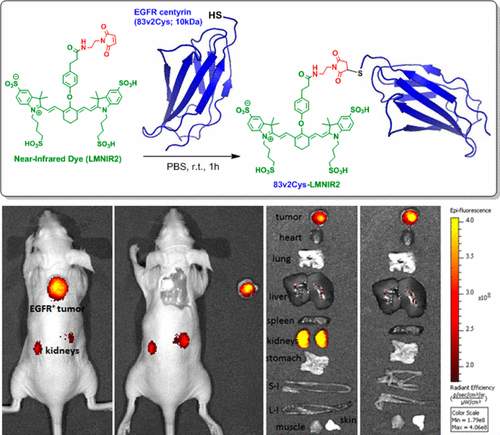当前位置:
X-MOL 学术
›
Bioconjugate Chem.
›
论文详情
Our official English website, www.x-mol.net, welcomes your
feedback! (Note: you will need to create a separate account there.)
Evaluation of a Centyrin-Based Near-Infrared Probe for Fluorescence-Guided Surgery of Epidermal Growth Factor Receptor Positive Tumors
Bioconjugate Chemistry ( IF 4.0 ) Pub Date : 2017-10-17 00:00:00 , DOI: 10.1021/acs.bioconjchem.7b00566 Sakkarapalayam M. Mahalingam , Vadim Y. Dudkin 1 , Shalom Goldberg 1 , Donna Klein 1 , Fang Yi 1 , Sunil Singhal 2 , Karyn T. O’Neil 1 , Philip S. Low
Bioconjugate Chemistry ( IF 4.0 ) Pub Date : 2017-10-17 00:00:00 , DOI: 10.1021/acs.bioconjchem.7b00566 Sakkarapalayam M. Mahalingam , Vadim Y. Dudkin 1 , Shalom Goldberg 1 , Donna Klein 1 , Fang Yi 1 , Sunil Singhal 2 , Karyn T. O’Neil 1 , Philip S. Low
Affiliation

|
Tumor-targeted near-infrared fluorescent dyes have the potential to improve cancer surgery by enabling surgeons to locate and resect more malignant lesions where good visualization tools are required to ensure complete removal of malignant tissue. Although the tumor-targeted fluorescent dyes used in humans to date have been either small organic molecules or high molecular weight antibodies, low molecular weight protein scaffolds have attracted significant attention because they penetrate solid tumors almost as efficiently as small molecules, but can be infinitely mutated to bind almost any antigen. Here we describe the use of a 10 kDa protein scaffold, a Centyrin, to target a near-infrared fluorescent dye to tumors that overexpress the epidermal growth factor receptor (EGFR) for fluorescence-guided surgery (FGS). We have developed and optimized the dose and time required for imaging small tumor burdens with minimal background fluorescence in real-time fluorescence-guided surgery of EGFR-expressing tumor xenografts in murine models. We demonstrate that the Centyrin-near-infrared dye conjugate (CNDC) binds selectively to human EGFR+ cancer cells with an EC50 of 2 nM, localizes to EGFR+ tumor xenografts in athymic nude mice and that uptake of the dye in xenografts is significantly reduced when EGFR are blocked by preinjection of excess unlabeled Centyrin. Taken together, these data suggest that CNDCs can be used for intraoperative identification and surgical removal of EGFR-expressing lesions and that Centyrins targeted to other tumor-specific antigens should prove similarly useful in fluorescence guided surgery of cancer. In addition, we demonstrate that the CNDC is detected in the NIR region of the spectrum and can be utilized for fluorescence-guided surgery (FGS). In addition, we propose that with its eventual complete clearance from EGFR-negative tissues and its quantitative retention in the tumor mass for >24 h, a Centyrin-targeted NIR dye should provide excellent tumor contrast when injected at least 6–8 h before initiation of cancer surgery in human patients.
中文翻译:

基于Centyrin的近红外探针对表皮生长因子受体阳性肿瘤的荧光引导手术的评估
以肿瘤为目标的近红外荧光染料具有使外科医生能够定位和切除更多恶性病变的潜力,从而有可能改善癌症手术,在需要良好的可视化工具以确保彻底清除恶性组织的地方。尽管迄今为止用于人类的靶向肿瘤的荧光染料要么是小的有机分子,要么是高分子量的抗体,但是低分子量的蛋白质支架却引起了极大的关注,因为它们几乎可以像穿透小分子一样有效地穿透实体瘤,但是可以无限突变。结合几乎所有抗原。在这里,我们描述了使用10 kDa蛋白质支架(Centyrin)将近红外荧光染料靶向过表达表皮生长因子受体(EGFR)的肿瘤,以进行荧光引导手术(FGS)。我们已经开发并优化了在鼠模型中对表达EGFR的肿瘤异种移植物进行实时荧光引导手术时,以最小的背景荧光成像最小的肿瘤负担所需的剂量和时间。我们证明了Centyrin-近红外染料偶联物(CNDC)选择性结合人EGFR+ EC 50为2 nM的癌细胞定位于EGFR +当通过预先注射过量的未标记的Centyrin阻断EGFR时,无胸腺裸鼠体内的肿瘤异种移植物和异种移植物中染料的摄取显着降低。综上所述,这些数据表明,CNDC可用于术中鉴定和手术去除表达EGFR的病变,针对其他肿瘤特异性抗原的Centyrins在荧光引导的癌症手术中也应证明同样有用。此外,我们证明了在光谱的NIR区域中检测到CNDC,并且可以将其用于荧光引导手术(FGS)。此外,我们建议其最终从EGFR阴性组织中完全清除,并在肿瘤块中定量保留> 24小时,
更新日期:2017-10-17
中文翻译:

基于Centyrin的近红外探针对表皮生长因子受体阳性肿瘤的荧光引导手术的评估
以肿瘤为目标的近红外荧光染料具有使外科医生能够定位和切除更多恶性病变的潜力,从而有可能改善癌症手术,在需要良好的可视化工具以确保彻底清除恶性组织的地方。尽管迄今为止用于人类的靶向肿瘤的荧光染料要么是小的有机分子,要么是高分子量的抗体,但是低分子量的蛋白质支架却引起了极大的关注,因为它们几乎可以像穿透小分子一样有效地穿透实体瘤,但是可以无限突变。结合几乎所有抗原。在这里,我们描述了使用10 kDa蛋白质支架(Centyrin)将近红外荧光染料靶向过表达表皮生长因子受体(EGFR)的肿瘤,以进行荧光引导手术(FGS)。我们已经开发并优化了在鼠模型中对表达EGFR的肿瘤异种移植物进行实时荧光引导手术时,以最小的背景荧光成像最小的肿瘤负担所需的剂量和时间。我们证明了Centyrin-近红外染料偶联物(CNDC)选择性结合人EGFR+ EC 50为2 nM的癌细胞定位于EGFR +当通过预先注射过量的未标记的Centyrin阻断EGFR时,无胸腺裸鼠体内的肿瘤异种移植物和异种移植物中染料的摄取显着降低。综上所述,这些数据表明,CNDC可用于术中鉴定和手术去除表达EGFR的病变,针对其他肿瘤特异性抗原的Centyrins在荧光引导的癌症手术中也应证明同样有用。此外,我们证明了在光谱的NIR区域中检测到CNDC,并且可以将其用于荧光引导手术(FGS)。此外,我们建议其最终从EGFR阴性组织中完全清除,并在肿瘤块中定量保留> 24小时,









































 京公网安备 11010802027423号
京公网安备 11010802027423号